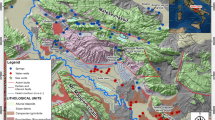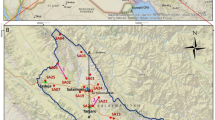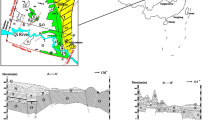Abstract
The Pleistocene Kimitsu aquifer was selected for examination of the relationship between groundwater age and chemical evolution of Ca(HCO3)2-type groundwater. For the most part, the aquifer is confined and composed mainly of quartz and feldspar with a small amount of calcite. The groundwater ages calculated by 14C were adjusted by using a carbon mass-balance method and corrected for effects of 14C diffusion. Groundwater ages in the Kimitsu aquifer vary from modern (upgradient) to approximately 2,400 years at 4.4 km from the edge of the recharge area. The 14C age was verified by groundwater velocity calculated from the hydraulic gradient and hydraulic conductivity. The confined groundwater evolved to Ca(HCO3)2-type around 50 years after recharge and this has been maintained for more than 8,300 years due to low chemical reactivity, derived from equilibrium with calcite, kaolinite and Ca-montmorillonite. In addition, high pH prevents the dissolution of Fe and Mn. Consequently, the rate of increase in electrical conductivity ranges from 10 to 30 μS/cm per 1,000 years. On the other hand, leakage from the deep region, which is recognized from high Cl– levels, causes remarkable increases in CH4 and HCO3 – concentrations, resulting in an apparent sulfidic zone at 500-m depth in most downgradient regions.
Resumo
O aquífero plistocénico Kimitsu foi selecionado para análise das relações entre a idade das águas subterrâneas e a evolução química dessas mesmas águas de tipo Ca(HCO3)2. Na sua maior parte, o aquífero é confinado e composto principalmente por quartzo e feldspato com uma pequena quantidade de calcite. A idade da água subterrânea, calculada a partir do 14C, foi ajustada através de um método de balanço de massa e corrigida para os efeitos de difusão do 14C. A idade da água subterrânea do aquífero Kimitsu varia desde moderna (a montante) até aproximadamente 2,400 anos a 4.4 km do centro da área de recarga. A idade 14C foi verificada pela velocidade da água subterrânea calculada a partir do gradiente hidráulico e da condutividade hidráulica. A água subterrânea confinada evoluiu para tipo Ca(HCO3)2 cerca de 50 anos após a recarga e esta situação mantem-se por mais de 8,300 anos, devido à limitada reatividade química, derivada do equilíbrio com a calcite, caulinite e montmorilonite-Ca. Para além disso, elevados valores de pH impedem a dissolução de Fe e Mn. Consequentemente, a taxa de incremento da condutividade elétrica varia de 10 a 30 μS/cm por cada 1,000 anos. Por outro lado, a percolação a partir de zonas profundas, que é reconhecida pelos valores elevados de Cl, causa incrementos importantes nas concentrações de CH4 e HCO3, resultando numa aparente zona sulfídrica a 500 m de profundidade na maioria das regiões a jusante.
Résumé
L’aquifère pléistocène de Kimitsu a été sélectionné pour étudier la relation entre l’âge des eaux souterraines et l’évolution chimique d’eaux souterraines de type Ca(HCO3)2. Pour l’essentiel, l’aquifère est captif et composé principalement de quartz et feldspath avec une faible quantité de calcite. Les âges de l’eau souterraine calculés par 14C ont été ajustés en utilisant la méthode d’équilibre de masse du carbone et corrigés des effets de la diffusion du 14C. Les âges des eaux souterraines de l’aquifère de Kimitsu sont comprises entre des âges récents dans la partie amont et environ 2400 ans pour les eaux souterraines situées à 4.4 km du bord de la zone de recharge. L’âge au 14C a été vérifié à partir du calcul de la vitesse des eaux souterraines en considérant le gradient et la conductivité hydraulique. L’eau souterraine confinée a évolué vers un type Ca(HCO3)2 environ 50 ans après la recharge, évolution qui s’est maintenue durant de plus de 8300 ans, à cause de la faible réactivité chimique, déduite de l’équilibre avec la calcite, kaolinite et Ca-montmorillonite. De plus, une forte valeur du pH empêche la dissolution du Fe et Mn. En conséquence, le taux d’augmentation de la conductivité électrique s’étend de 10 à 30μS/cm par 1,000 ans. Par ailleurs, des flux d’eau provenant des parties profondes de l’aquifère, reconnues comme ayant des niveaux de concentrations en Cl– élevées, provoquent des augmentations considérables des concentrations de CH4 et HCO3 –, et des zones évidentes riches en sulfures à des profondeurs de -500m dans la plupart des régions situées en aval hydraulique.
Resumen
Se seleccionó el acuífero Kimitsu para examinar la relación entre la edad del agua subterránea y la evolución química de agua subterránea de tipo Ca(HCO3)2. En su mayor parte, el acuífero está confinado y compuesto principalmente de cuarzo y feldespato con una pequeña cantidad de calcita. Las edades del agua subterránea calculadas con 14C se ajustaron utilizando un método de balance de masa de carbono y se corrigieron por efectos de la difusión de 14C. Las edades del agua subterránea en el acuífero Kimitsu varían desde modernas (gradiente arriba) hasta aproximadamente 2,400 años a 4.4 km del límite del área de recarga, La edad 14C se verificó a través de la velocidad del agua subterránea calculada a partir del gradiente hidráulico y la conductividad hidráulica. El agua subterránea confinada evolucionó hacia el tipo Ca(HCO3)2-en alrededor de 50 años después de la recarga y esto se ha mantenido por más de 8,300 años debido a la baja reactividad química derivada del equilibrio con la calcita, caolinita y montmorillonita Ca. Además, el alto pH previene la disolución de Fe y Mn. Consecuentemente, el ritmo de incremento de la conductividad eléctrica está entre 10 y 30 μS/cm cada 1,000 años. Por otra parte, la filtración de la región profunda, reconocida a través de altos niveles de Cl–, causa marcados incrementos en la concentración de CH4 y HCO3 –, lo que resulta en una aparente zona sulfurosa a 500-m de profundidad en la mayoría de las regiones gradiente abajo.









Similar content being viewed by others
References
Appelo CAJ, Postma D (2007) Geochemistry, groundwater and pollution, 2nd edn. Balkema, Amsterdam
Bath AH, Edmunds WM, Andrews JN (1979) Palaeoclimatic trends deduced from the hydrochemistry of a Triassic sandstone aquifer, United Kindgom. In: IAEA (ed) Isotope hydrology, vol II. IAEA, Vienna, pp 545–568
Chapelle FH, McMahon PB (1991) Geochemistry of dissolved inorganic carbon in a coastal plain aquifer. 1. Sulfate from confining beds as an oxidant in microbial CO2 production. J Hydrol 127:85–108
Chapelle FH, Knobel LL (1983) Aqueous geochemistry and the exchangeable cation composition of glauconite in the Aquia Aquifer, Maryland. Ground Water 21:343–352
Chiba Prefecture (1983) Chikasui tekisei riyouryou chousa houkokusyo -Kimitsu to Kisarazu [Survey report for suitable groundwater use: Kimitsu and Kisarazu]. Chiba Prefecture, Chiba, Japan
Compilation Committee of History of Kimitsu City (1996) Kimitsu-shi shi Shizen-hen [History of Kimitsu City: nature]. Daiichi-hoki, Tokyo
Downing RA, Smith DB, Pearson FJ, Monkhouse RA, Otlet RL (1977) The age of groundwater in the Lincolnshire limestone, England and its relevance to the flow mechanism. J Hydrol 33:201–216
Drever JI (1988) The geochemistry of natural waters. Prentice Hall, Englewood Cliffs, NJ
Edmumds WM, Walton NRG (1983) The Lincolnshire Limestone: hydrogeochemical evolution over a ten-year period. J Hydrol 61:201–211
Edmunds WM, Smedley PL (2000) Residence time indicators in groundwater: the East Midlands Triassic sandstone aquifer. Appl Geochem 15:737–752
Fontes JC, Garnier JM (1979) Determination of the initial 14C activity of the total dissolved carbon: a review of the existing models and a new approach. Water Resour Res 15(2):399–413
Freeze RA, Cherry AC (1979) Groundwater. Prentice Hall, Englewood Cliffs, NJ
Galego Fernandes P, Carreira PM (2008) Isotopic evidence of aquifer recharge during the last ice age in Portugal. J Hydrol 361:291–308
Gallagher D, McGee EJ, Kalin RM, Mitchell PI (2000) Performance of models for radiocarbon dating of groundwater: an appraisal using selected Irish aquifers. Radiocarbon 42(2):235–248
Goldich SS (1938) A study in rock-weathering. J Geol 46:17–58
Haines TS, Lloyd JW (1985) Controls on silica in groundwater environments in the United Kingdom. J Hydrol 81:277–295
Hamada Y, Tanaka T (2003) Carbon-13 natural abundances of organic matter and carbon dioxide in soil profiles on Tsukuba upland (in Japanese with English abstract). TERC Tukuba Univ 4:19–30
Hwang JY (1988) Dissolution of chlorite and sericite by the treatment with dilute H2SO4 solution. J Clay Sci Soc Jpn 28(3):119–125
Jakobsen R, Postma D (1994) In situ rates of sulfate reduction in an aquifer (Rømø, Denmark) and implications for the reactivity of organic matter. Geol 22:1103–1106
Japanese Association of Groundwater Hydrology (2000) Basics of groundwater quality. Riko Tosho, Tokyo
Kaneko N, Maekawa T, Igari S (2002) Generation of archaeal methane and its accumulation mechanism into interstitial water (in Japanese with English abstract). J Jpn Assoc Pet Technol 67(1):97–110
Kashiwagi Y, Shikazono N (2005) Water–rock reaction in sequestration of carbon dioxide in sedimentary basin: a case study of Boso Peninsula, Chiba, central Japan (in Japanese with English abstract). J Groundw Hydrol 47:65–80
Kazemi GA, Lehr JH, Perrochet P (2006) Groundwater age. Wiley, Hoboken, NJ
Kennedy CD, Genereux DP (2007) 14C groundwater age and the importance of chemical fluxes across aquifer boundaries in confined Cretaceous aquifers of North Carolina, USA. Radiocarbon 49(3):1181–1203
Kitagawa H, Masuzawa T, Nakamura T, Matsumoto E (1993) A batch preparation method for graphite targets with low background for AMS 14C measurements. Radiocarbon 35:295–300
Lawrence AR, Lloyd JW, Marsh JM (1977) Hydrochemistry and Ground-water mixing in part of the Lincolnshire Limestone aquifer, England. Ground Water 14(5):320–327
Machida I, Suzuki Y, Takeuchi M (2010) The 14C age of confined groundwater in as sandy-muddy Pleistocene. IAH Selected Papers 16, CRC, Delft, The Netherlands
McMahon PB, Chapelle FH (1991) Geochemistry of dissolved inorganic carbon in a Coastal Plain aquifer. 2. Modeling carbon sources, sinks, and δ13C evolution. J Hydrol 127:109–135
Ministry of Education, Culture, Sports, Science and Technology, Japan (1993) Method of radiocarbon analysis, MEXT (in Japanese). http://www.kankyo-hoshano.go.jp/series/main_pdf_series_25.html. Accessed 1 March 2013
Ministry of Education, Culture, Sports, Science and Technology, Japan (2002) Method of tritium analysis, MEXT (in Japanese). http://www.kankyo-hoshano.go.jp/series/lib/No9-1.pdf. Accessed 1 March 2013
Mokrik R, Mažeika J, Baublytė A, Martma T (2009) The groundwater age in the Middle-Upper Devonian aquifer system, Lithuania. Hydrogeol J 17:871–889
Nakajima T, Watanabe M (2005) Geology of the Futtsu District (in Japanese with English abstract). Quadrangle Series, 1:50,000. Geological Survey of Japan, AIST, Ibaraki, Japan
Plummer LN (1977) Defining reactions and mass transfer in part of the Floridan aquifer. Water Resour Res 13(5):801–812
Plummer LN, Busby JF, Lee RW, Hanshaw BB (1990) Geochemical modeling of the Madison aquifer in parts of Montana, Wyoming, and South Dakota. Water Resour Res 26(9):1981–2014
Sanford WE (1997) Correcting for diffusion in carbon-14 dating of ground water. Ground Water 35(2):357–361
Stewart MK, Thomas JT (2002) Moutere Valley groundwater: nature and recharge from isotopes and chemistry. IGNS science report 2002/22, Institute of Geological and Nuclear Sciences, Lower Hutt, New Zealand
Stewart MK, Thomas JT, Norris M, Trompetter V (2004) Paleogroundwater in the Moutere gravel aquifers near Nelson, New Zealand. Radiocarbon 46(2):517–529
Stute M, Deak J (1989) Environmental isotope study (14C, 13C, 18O, D, noble gases) on deep groundwater circulation systems in Hungary with reference to paleoclimate. Radiocarbon 31(3):902–918
Sugimori H, Yokoyama T, Murakami T (2002) Effects of composition and structure on dissolution rates and mechanisms of micas and chlorites at pH 3. Jpn Geosci Meeti B006-P004, Japan Geoscience Union, Tokyo
Sültenfuß J, Purtschert R, Führböter JF (2011) Age structure and recharge conditions of a coastal aquifer (northern Germany) investigated with 39Ar, 14C, 3H, He isotopes and Ne. Hydrogeol J 19:221–236
Takamura H (2004) The techniques and tools of the Kazusabori well-boring. Chikyu Kankyo Kenkyu Rissho Univ 6:37–50
Takeuchi M, Nanba K, Iwamoto H, Nirei H, Kusuda T, Kazaoka O, Owaki M, Furuya K (2005) In situ bioremediation of a cis-dichloroethylene-contaminated aquifer utilizing methane-rich groundwater from an uncontaminated aquifer. Water Res 39:2438–2444
Tardy Y (1971) Characterization of the principal weathering types by the geochemistry of waters from European and African crystalline massifs. Chem Geol 7:253–271
Truesdell AH, Jones BF (1973) WATEQ, a computer program for calculating chemical equilibria of natural waters. USGS NITS PB-220 464, US Geological Survey, Reston, VA
Van Stempvoort D, Maathuis H, Jaworski E, Mayer B, Rich K (2004) Oxidation of fugitive methane in ground water linked to bacterial sulfate reduction. Ground Water 43(2):187–199
Yabusaki S, Tsujimura M, Tase N (2003) Recent trend of tritium concentration in precipitation in Kanto Plane, Japan. Annu Rep Inst Geosci (Univ of Tsukuba) 4:119–124
Yoshikawa H, Nakahara H, Imamura M, Kobayashi K, Nakanishi T (2005) Determination of 14C in volcanic gas by accelerator mass spectrometry. Radiocarbon 47(2):211–219
Acknowledgements
The authors would like to thank the special corporation of the Environment Preservation Division in Kimitsu City, Chiba Prefecture. The authors were advised on the hydrogeology in Kimitsu by Dr. Hisashi Nirei, an honorary professor of Ibaraki University, and Mr. Yoshikazu Suzuki, the president of Geo-pollution Investigation and Remediation with Kimitsu System.
Author information
Authors and Affiliations
Corresponding author
Rights and permissions
About this article
Cite this article
Machida, I., Suzuki, Y. & Takeuchi, M. Carbon-14 age and chemical evolution of Ca(HCO3)2-type groundwater of age less than 8,000 years in a confined sandy and muddy Pleistocene aquifer, Japan. Hydrogeol J 21, 1289–1305 (2013). https://doi.org/10.1007/s10040-013-0990-3
Received:
Accepted:
Published:
Issue Date:
DOI: https://doi.org/10.1007/s10040-013-0990-3




